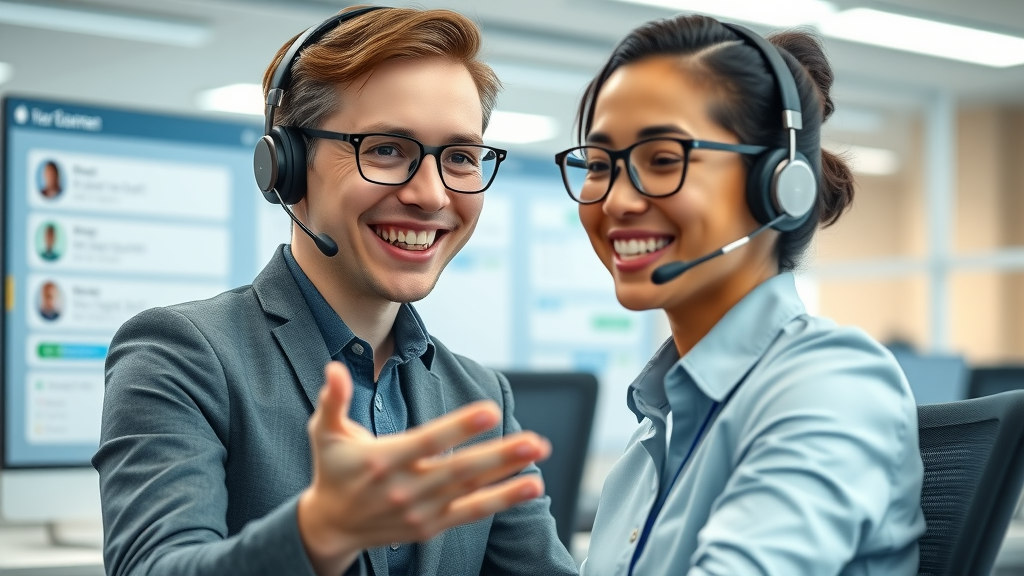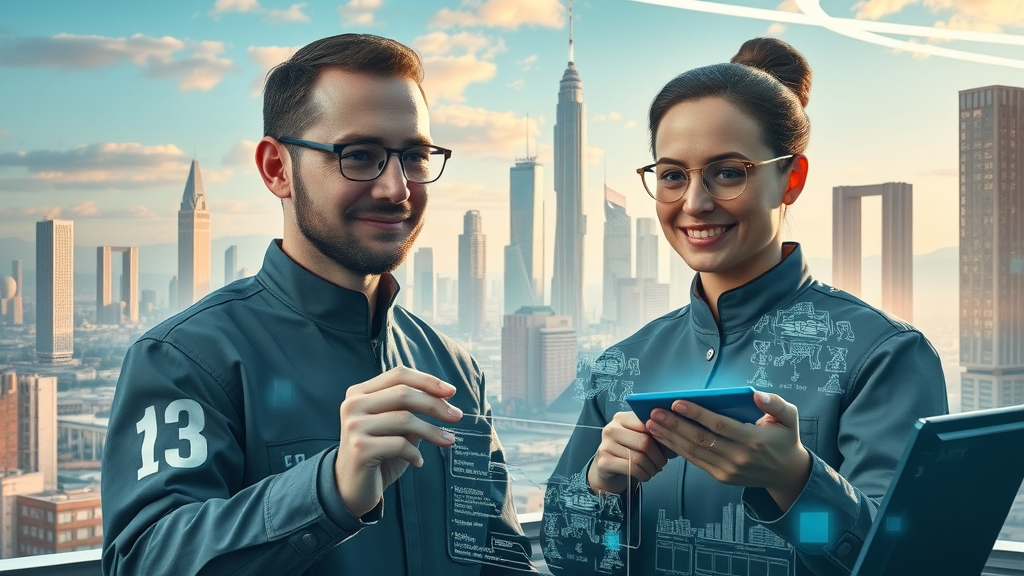Did you know that 70% of AI errors can be traced back to context misinterpretation? As artificial intelligence redefines how we work and innovate, a hidden force quietly determines whether your AI systems succeed or fall short: context engineering . This comprehensive guide uncovers how mastering context is the crucial difference between ordinary and truly transformational AI. Read on to learn practical strategies and real-world examples that will give you an unbeatable edge with next-gen intelligent systems.
Why Context Engineering is the Hidden Driver of AI Precision
- Did you know that 70% of AI errors can be traced back to context misinterpretation? Discover how context engineering is becoming the linchpin of next-gen intelligent systems.

- Explore the unconventional truth: AI systems are only as smart as the context that surrounds them.
In every successful AI system, context engineering acts as the silent engine powering accuracy and relevance. Unlike single prompt solutions, today's large language models (LLMs) rely on dynamic systems that constantly incorporate new information, conversation history, and relevant context containers. Without proper context, even the smartest algorithms struggle to deliver accurate outputs or understand user intent. That's why a skilled context engineer has become indispensable, especially in mission-critical domains like healthcare, customer support, and enterprise automation.
This precision isn't merely about stuffing more data; it's about curating structured, persistent, and relevant context windows that empower AI agents to access, recall, and reason across vast pools of information. Effective context engineering can reduce costly errors, improve user satisfaction in LLM app delivery, and position your organization to harness the true promise of AI. In the sections ahead, you’ll see how context engineers shape everything from tool call integration and data flow management to advanced AI collaboration and compliance, unlocking potent new capabilities for intelligent applications.
Mastering Context Engineering: An Essential Guide for Future AI Leaders
What you'll learn about context engineering
- The definition and scope of context engineering in modern AI
- Key roles and responsibilities of a context engineer
- How context engineering compares with prompt engineering

- Use-cases for context windows, tool calls, and LLM applications
- Best practices to ensure precision in AI agents and automated systems
As AI technology evolves, aspiring leaders must go beyond prompt engineering to truly excel. This guide will empower you to understand the science of filling the context window , orchestrate building dynamic systems with persistent memory, and apply context engineering best practices to maximize LLM app ROI. You'll learn how to design, test, and optimize AI agent workflows that solve complex, multi-turn tasks—making you a valuable asset in any cutting-edge AI team.
You'll also discover why context engineers are at the center of the new LLM era. From managing multi-agent collaboration on agentic systems, to integrating automated tool calls, to developing adaptive context windows for varied tasks, you'll gain practical knowledge that separates routine outputs from exceptional AI performance.
Defining Context Engineering: Foundations and Evolution
Understanding the context engineer role
- How context engineering emerged as the backbone of AI accuracy
- Differences between prompt engineering and context engineering
"Context engineering is the art and science of shaping AI cognition through curated information." – Dr. Fiona Chen, AI Researcher

A context engineer is the mastermind who ensures LLM and AI systems maintain awareness far beyond what a single prompt supplies. With roots in information science and cognitive psychology, context engineering has rapidly become the backbone for scalable, reliable AI. Early on, developers discovered that without curated conversation history, tool call data, and relevant information, even advanced models produced inconsistent or incorrect outputs. Now, context engineers build and maintain the "working memory"—or context window—so the model sees everything it needs, exactly when it needs it.
The difference between prompt engineering and context engineering is critical. Prompt engineers craft specific instructions for each query, optimizing single interactions. By contrast, context engineers design persistent information architectures that enable models to reference conversation and task history, integrate knowledge from vector stores, and orchestrate memory across LLM calls. These persistent, adaptive systems are what make LLM applications scalable, compliant, and capable of handling complex, multistep flows.
Context Engineering vs Prompt Engineering: The Art and Science of AI Communication
Core principles: art and science in context engineering

Effective context engineering blends the art and science of delivering exactly the right information and tools to each step of an AI agent's workflow. The science comes from designing structured output flows, persistent agent memories, and reliable context windows that span entire sessions or applications. The art lies in intuitively understanding which pieces of information are relevant, and how to present them in ways that support the model’s decision-making.
In contrast, prompt engineering emphasizes the rapid and tactical refinement of standalone queries. While a prompt engineer may specialize in iterating model instructions for a specific goal, context engineers consider longer-term objectives. They fill the context window with accumulated insights, supporting relevant info across multiple tool calls and agentic systems—an approach inspired by thinkers like Andrej Karpathy and other AI visionaries. Ultimately, the art and science of filling the context window shapes everything from data curation and workflow automation to advanced reasoning in LLM apps.
Prompt engineering: rapid iteration vs. nuanced context studies
| Dimension | Context Engineering | Prompt Engineering |
|---|---|---|
| Focus | Curated, persistent background | Direct model instructions |
| Typical Role | Context engineer | Prompt engineer |
| Effect on LLM | Improved retention and coherence | Focused outputs |
Prompt engineering shines for rapid iteration and generating quick, targeted responses, especially for one-off tasks or single-prompt queries. Context engineering, on the other hand, enables nuanced, session-spanning interactions that require persistent memory, agent orchestration, and tailored tool call management for building dynamic systems at scale. Mastering both is essential for future-ready AI teams.
How a Context Engineer Shapes LLM App Success
LLM application development: Why context engineering is critical
Modern LLM applications are complex, multi-agent systems that rely heavily on context engineers. From a technical perspective, context engineers are responsible for filling the context window with relevant conversation history, tool call outputs, and knowledge graph references. This orchestration makes sure the AI agent always operates with full awareness, producing more accurate responses and adaptive reasoning.
Precise context engineering leads to robust workflows that empower AI agents to switch tasks seamlessly, incorporate new data sources, and even manage compliance for regulations like HIPAA or GDPR. Without intelligent context management, LLM app performance can degrade rapidly, resulting in poor user experiences and costly mistakes. Whether developing chatbots, virtual assistants, or data analysis tools, context engineers are essential to maximizing LLM app ROI and reliability.
Tool calls: Integrating context for AI agent workflows
- Enhancing user satisfaction in llm app ecosystems through tailored contexts

- Examples of tool call optimization and automated tool calls
Tool calls are mechanisms by which AI models invoke external resources—APIs, databases, or knowledge bases—to retrieve or manipulate data. A context engineer’s job is to script context flows so the AI agent has exactly the right context before each tool call and knows how to interpret results once they're returned. For example, by supplying the AI with enriched context on a patient's history before a medical query, context engineers ensure automated tool calls deliver accurate, compliant, and relevant output.
Examples of this approach include:
- Customer service bots referencing full conversation history and past purchases before answering support questions.
- Healthcare agents checking compliance modules and retrieving medical records in response to tool call requests.
- Financial apps assembling session-based context to automate credit checks, payment initiation, and fraud detection workflows.
Context Windows: Extending AI Memory
What is a context window in context engineering?

- Designing flexible context windows for varied ai agent tasks
- Managing large-scale conversations with optimized context windows
A context window is the span of memory or history that an AI model uses to inform its outputs. Think of it as the working memory for the AI—the larger and more precisely designed the window, the more accurately the agent can reference relevant information, conversation history, and past tool calls. The science of context engineering involves filling the context window with a careful mix of user messages, system states, tool call data, and persistent memory structures without overwhelming or distracting the LLM.
For teams building multi-agent systems or managing enterprise-scale conversations, designing flexible context windows is paramount. This means segmenting context for different tasks, summarizing long conversations, and ensuring vital data persists across sessions. By managing what part of context remains 'top of mind' for the model, context engineers enable accurate, coherent, and efficient responses, even when LLMs are juggling hundreds of tool calls or agent handoffs.
AI Agents and Context Engineering: Building Sophisticated LLM Apps
Coordinating multiple ai agents with advanced context mechanisms

Modern AI systems often deploy multiple AI agents , each specializing in distinct workflows or tool calls. A context engineer orchestrates how information flows between these agents, ensuring each has the context needed to execute its responsibilities. By coordinating memory, summarizing shared history, and distributing relevant info, context engineers enable collaborative intelligence—where agents can ask, answer, and problem-solve together.
In complex LLM applications , agent coordination also supports handoffs—where one AI agent picks up the context left by another without missing crucial information. For example, a chatbot might transfer a conversation to a billing agent without making the user repeat details, all managed behind the scenes through engineered context overlays. This enables agentic systems that are robust, efficient, and capable of solving interdisciplinary problems using shared memory and real-time communication.
How context engineering fosters collaborative intelligence
The power of context engineering goes beyond individual agent optimization. By building mechanisms for collaborative context sharing , engineers enable AI agents to function as a unified, dynamic system. This means agents can share conversation history, distribute results from tool calls, and coordinate actions as a team, much like a well-practiced group of human experts.
This approach reduces redundant tool calls, minimizes inconsistencies, and increases overall LLM app reliability. Real-world applications include virtual teams that manage multi-channel customer support, research assistants who share context across scientific queries, and intelligent tutors who adapt their teaching based on prior learner interactions.
Situational Examples: Context Engineering in Real-World LLM Applications
- Case Study I: Customer support bots leveraging context for personalized responses

- Case Study II: Healthcare LLM apps ensuring context-led compliance in patient interactions
Case Study I: A leading e-commerce platform deployed context engineering within their support bots, integrating conversation history, user preferences, and purchase data into each response. The bots automatically referenced relevant tickets and tool calls to resolve complex issues with unprecedented precision, boosting customer satisfaction and reducing escalation rates.
Case Study II: In healthcare, LLM apps engineered with compliant context flows pull medical history, previous tool calls, and ongoing treatment plans before each patient interaction. Context engineers ensured tool calls adhered to privacy regulations, and context windows were designed to capture critical, session-spanning insights—dramatically improving care quality and operational safety.
- Tools and platforms supporting context engineer workflows: OpenAI, LangChain, Agility, Hugging Face
The top tools for context engineering today include OpenAI for LLM development, LangChain for chaining context-aware tasks, Agility for enterprise integration, and Hugging Face for model deployment and data orchestration.
The Future of Context Engineering in AI Development
Current innovations and upcoming challenges

As context engineering matures, we see emerging innovations in dynamic context compression , real-time memory expansion, and AI-driven context summarization. Technologies for automatic context pruning and privacy-safe data segmentation are also on the rise. The next frontier includes context-aware reinforcement learning, autonomous multi-agent orchestration, and context windows that grow alongside working memory to accommodate increasingly complex LLM apps.
Challenges remain around scaling context for enterprise use, ethical management of sensitive context (such as medical or financial records), and ensuring long-term accuracy as agents evolve. Solving these challenges will demand adaptable context engineer roles, hybrid skill sets, and deep cross-disciplinary understanding.
Ethics and safety in context engineering for next-gen ai agents and llm application landscapes
With great power comes great responsibility. The ability to design persistent, expansive context windows means context engineers must prioritize ethics, safety, and user consent . In sensitive domains, such as healthcare and finance, guardrails must be put in place to ensure AI agents never expose, misuse, or hallucinate confidential data.
Best practices include privacy-aware context segmentation, regular safety audits, transparency for users on context use, and real-time monitoring for anomalous behavior. As context windows and agentic systems become more sophisticated, context engineers will lead the way in defining new ethical standards for responsible AI.
Key Takeaways for Aspiring Context Engineers
- Invest in understanding both the art and science of context engineering
- Focus on tool call integration for maximum LLM performance
- Leverage best practices in context window management and agent orchestration
If you’re looking to future-proof your career in AI, developing expertise in context engineering will make you invaluable—whether you’re designing next-gen chatbots, building dynamic systems, or collaborating on complex LLM application workflows.
Popular Questions About Context Engineering
What is the meaning of contextual engineering?
- Contextual engineering refers to designing intelligent systems that factor in surrounding data, history, and intent. In AI, context engineering ensures each model output is informed by broader situational awareness, not just narrow prompts.
Who coined context engineering?
- The term 'context engineering' began appearing widely in AI literature around 2019, credited to pioneering researchers and practitioners in the LLM ecosystem who recognized the need for deeper, more adaptable contextual cues to improve model reliability.
What is context engineering vs prompt engineering?
- While prompt engineering fine-tunes individual model instructions, context engineering crafts an adaptive and persistent flow of information, enabling AI to maintain relevant insights across longer sessions and diverse applications.
How does context work in AI?
- Context enables AI to reference previous information and user intent across tasks, conversations, and tools. By managing context windows, tool calls, and agent memories, context engineers build more accurate and responsive systems.
Frequently Asked Questions
-
What skills are essential for becoming a context engineer?
- Strong knowledge of LLM architectures, advanced workflow automation, prompt and context design, robust data management, and ethical compliance standards.
-
How can context engineering maximize LLM app ROI?
- By designing persistent and adaptive context flows, context engineers minimize unnecessary tool calls, reduce errors, enable agent collaboration, and boost user retention—directly impacting LLM app efficiency and effectiveness.
-
Which tools are best for advanced context engineering projects?
- OpenAI, LangChain, Agility, Hugging Face, and custom context window managers tailored to your workflow.
-
What are the ethical considerations for context engineering in sensitive applications?
- Always prioritize privacy, user consent, regulatory compliance, and transparent context management. Institute regular reviews and audit trails for sensitive context flows.
Case Quote: Frontline Insights from a Leading Context Engineer
"The difference between an average AI and a truly transformative solution lies in the power of engineered context." – Jamal Patel, Principal Context Engineer, Agility-Engineers
Real-World Video Demo: Building a Context-Driven LLM Application (Video 1)
- Watch an in-depth walkthrough demonstrating how a context engineer designs context windows and integrates tool calls in a healthcare LLM platform.
Context Engineering in Action: Agent Coordination Showcase (Video 2)
- See multi-agent systems powered by context engineering collaborate on complex workflows in live llm application environments.
Interview: AI Agents and Context Windows Explained for Beginners (Video 3)
- An expert context engineer answers common questions about AI agents, context windows, and the future of llm applications.
Connect With Expert Context Engineers and Advance Your Career
- Ready to innovate? Join our network of engineers and push the boundaries of context engineering: https://www.agility-engineers.com/
Conclusion
Take actionable steps: master the art and science of context engineering, integrate advanced tool calls, and manage context windows to build next-level, reliable AI applications—then join a network of experts to keep learning and leading in the field.
Sources
- OpenAI Research – https://www.openai.com/research/
- LangChain Blog – https://www.langchain.com/blog/
- Hugging Face Docs – https://huggingface.co/docs
- Agility Engineers – https://agility-engineers.com/resources/
- arXiv: Context Engineering in LLM Applications – https://arxiv.org/abs/2305.07254
To deepen your understanding of context engineering and its pivotal role in enhancing AI accuracy, consider exploring the following resources:
- “Context Engineering: A Guide With Examples” ( datacamp.com )
This guide provides practical examples and strategies for implementing context engineering, illustrating how it improves AI performance by effectively managing information flow.
- “Context Engineering: Going Beyond Prompt Engineering and RAG” ( thenewstack.io )
This article delves into the evolution of AI development, highlighting how context engineering extends beyond traditional prompt engineering and retrieval-augmented generation to create more dynamic and responsive AI systems.
By engaging with these resources, you’ll gain valuable insights into the methodologies and applications of context engineering, empowering you to develop AI systems that are both accurate and contextually aware.
 Add Row
Add Row  Add
Add 




Write A Comment